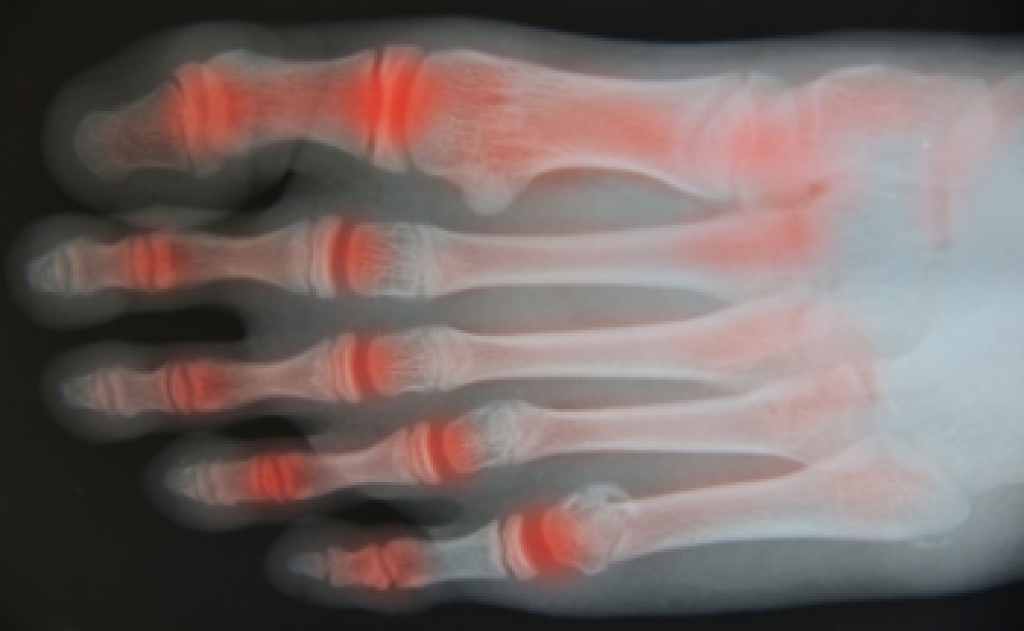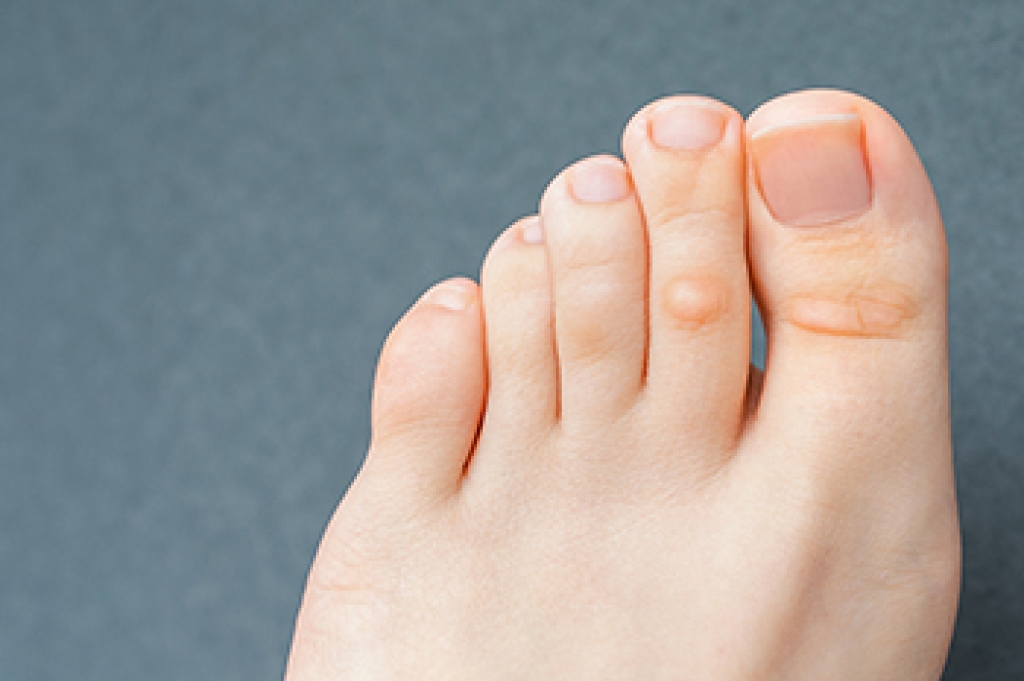Connect With Us
Blog
Arthritis Can Be Found in the Toes
 The joints in the body are affected when arthritis is present. The toes are a common place for this condition to develop, and it is often accompanied by severe pain and discomfort. Some of the symptoms that patients experience can include loss of toe function, swelling, and inflammation. The most common form of arthritis is known as osteoarthritis, and it affects the cartilage between the joints of the toes. Mild relief may be found when shoes are worn that have adequate room for the toes to move in, and it may also help to use a contrast bath. This is defined as putting the foot in a tub of ice water for several seconds, followed by putting the same foot in a bucket of warm water for the same amount of time. For severe arthritis in the toes, medical attention may be needed for relief. If you have symptoms of arthritis in the toes, please speak with a podiatrist who can guide you toward correct treatment solutions.
The joints in the body are affected when arthritis is present. The toes are a common place for this condition to develop, and it is often accompanied by severe pain and discomfort. Some of the symptoms that patients experience can include loss of toe function, swelling, and inflammation. The most common form of arthritis is known as osteoarthritis, and it affects the cartilage between the joints of the toes. Mild relief may be found when shoes are worn that have adequate room for the toes to move in, and it may also help to use a contrast bath. This is defined as putting the foot in a tub of ice water for several seconds, followed by putting the same foot in a bucket of warm water for the same amount of time. For severe arthritis in the toes, medical attention may be needed for relief. If you have symptoms of arthritis in the toes, please speak with a podiatrist who can guide you toward correct treatment solutions.
Arthritis can be a difficult condition to live with. If you are seeking treatment, contact Alex Kim, DPM from AVID Foot & Ankle Center. Our doctor can provide the care you need to keep you pain-free and on your feet.
Arthritic Foot Care
Arthritis is a joint disorder that involves the inflammation of different joints in your body, such as those in your feet. Arthritis is often caused by a degenerative joint disease and causes mild to severe pain in all affected areas. In addition to this, swelling and stiffness in the affected joints can also be a common symptom of arthritis.
In many cases, wearing ill-fitting shoes can worsen the effects and pain of arthritis. Wearing shoes that have a lower heel and extra room can help your feet feel more comfortable. In cases of rheumatoid arthritis, the arch in your foot may become problematic. Buying shoes with proper arch support that contour to your feet can help immensely.
Alleviating Arthritic Pain
- Exercises that stretch the foot can prevent further pain and injury and increase mobility
- Most of the pain can be alleviated with anti-inflammatory drugs, heat, and topical medications
- Massages can help temporarily alleviate pain.
It is best to see your doctor for the treatment that is right for your needs and symptoms. Conditions vary, and a podiatrist can help you determine the right method of care for your feet.
If you have any questions please feel free to contact our office located in Little Elm, TX . We offer the newest diagnostic tools and technology to treat your foot and ankle needs.
Risks of Sports-Related Injuries
Playing sports is common among youth and often continues as you become an adult. Kids and adults are both at risk of sports-related injuries. A few simple ways to prevent getting hurt while playing sports include warming up before you start, not exercising more than necessary, and stopping when you feel extreme pain. Most sports injuries are the result of doing too much too fast, thinking you can do more than you can, over training, faulty equipment, and accidents. The most common sports injuries are heel pain, stress fractures, and Achilles tendonitis. Athletes also are at risk of twisted or sprained ankles and, in some cases, broken bones. In case of a sports-related injury, it is suggested that you resist the idea of playing through the pain and, instead, stop the activity immediately. Ice, compression and elevation should follow. It is wise to consult a podiatrist as soon as possible for a full diagnosis and treatment options.
Sports related foot and ankle injuries require proper treatment before players can go back to their regular routines. For more information, contact Alex Kim, DPM of AVID Foot & Ankle Center. Our doctor can provide the care you need to keep you pain-free and on your feet.
Sports Related Foot and Ankle Injuries
Foot and ankle injuries are a common occurrence when it comes to athletes of any sport. While many athletes dismiss the initial aches and pains, the truth is that ignoring potential foot and ankle injuries can lead to serious problems. As athletes continue to place pressure and strain the area further, a mild injury can turn into something as serious as a rupture and may lead to a permanent disability. There are many factors that contribute to sports related foot and ankle injuries, which include failure to warm up properly, not providing support or wearing bad footwear. Common injuries and conditions athletes face, including:
- Plantar Fasciitis
- Plantar Fasciosis
- Achilles Tendinitis
- Achilles Tendon Rupture
- Ankle Sprains
Sports related injuries are commonly treated using the RICE method. This includes rest, applying ice to the injured area, compression and elevating the ankle. More serious sprains and injuries may require surgery, which could include arthroscopic and reconstructive surgery. Rehabilitation and therapy may also be required in order to get any recovering athlete to become fully functional again. Any unusual aches and pains an athlete sustains must be evaluated by a licensed, reputable medical professional.
If you have any questions please feel free to contact our office located in Little Elm, TX . We offer the newest diagnostic and treatment technologies for all your foot and ankle needs.
Dealing with Corns
Corns can sometimes be confused with calluses if you don’t know what to look (and feel) for. Corns can be painful and are either hard or soft. Hard corns, the most common type of corn, are caused by repeated pressure or friction. Soft corns are typically lighter in color and rubbery in texture. They usually form between toes. The best way to prevent corns from developing is to wear shoes that fit well and don’t cause pressure or friction on any part of your feet. Keep your toenails trimmed—but not so short that they grow into surrounding skin. Moisturize your feet daily and avoid wearing shoes without socks. People with diabetes, skin disorders or circulation problems would be wise not attempt to remove corns themselves, as such home remedies can sometimes lead to bleeding and infection. For safe and effective treatment for painful corns, it's a good idea to make an appointment with a podiatrist. They can also offer more tips and techniques for avoiding corns from developing in the first place.
If you have any concerns regarding your feet and ankles, contact Alex Kim, DPM of AVID Foot & Ankle Center. Our doctor will treat your foot and ankle needs.
Corns: What Are They? and How Do You Get Rid of Them?
Corns can be described as areas of the skin that have thickened to the point of becoming painful or irritating. They are often layers and layers of the skin that have become dry and rough, and are normally smaller than calluses.
Ways to Prevent Corns
There are many ways to get rid of painful corns such as wearing:
- Well-fitting socks
- Comfortable shoes that are not tight around your foot
- Shoes that offer support
Treating Corns
Treatment of corns involves removing the dead skin that has built up in the specific area of the foot. Consult with Our doctor to determine the best treatment option for your case of corns.
If you have any questions, please feel free to contact our office located in Little Elm, TX . We offer the newest diagnostic and treatment technologies for all your foot care needs.
What Is the Purpose of Foot Arches?
The arch is the curved area in the center sole of the foot. At birth, babies do not have arches in their feet, but most will develop arches over time. Those who don’t develop arches have congenital flat feet, which are usually asymptomatic. It is also possible to develop arches normally and then lose them over time for a variety of reasons. This is known as acquired flat feet, and is often accompanied by foot pain or discomfort. But why do we have arches in the first place? The arch of the foot is a very useful structure. It helps the feet stand, stay balanced, run, walk, and jump by adding flexibility and springiness to the foot. With an arch, the foot is better able to absorb shock from physical activities, and the body’s weight is more evenly distributed around the surface of the foot. If you have flat feet and are experiencing any foot pain, please seek the care of a podiatrist.
Flatfoot is a condition many people suffer from. If you have flat feet, contact Alex Kim, DPM from AVID Foot & Ankle Center. Our doctor will treat your foot and ankle needs.
What Are Flat Feet?
Flatfoot is a condition in which the arch of the foot is depressed and the sole of the foot is almost completely in contact with the ground. About 20-30% of the population generally has flat feet because their arches never formed during growth.
Conditions & Problems:
Having flat feet makes it difficult to run or walk because of the stress placed on the ankles.
Alignment – The general alignment of your legs can be disrupted, because the ankles move inward which can cause major discomfort.
Knees – If you have complications with your knees, flat feet can be a contributor to arthritis in that area.
Symptoms
- Pain around the heel or arch area
- Trouble standing on the tip toe
- Swelling around the inside of the ankle
- Flat look to one or both feet
- Having your shoes feel uneven when worn
Treatment
If you are experiencing pain and stress on the foot you may weaken the posterior tibial tendon, which runs around the inside of the ankle.
If you have any questions, please feel free to contact our office located in Little Elm, TX . We offer the newest diagnostic and treatment technologies for all your foot care needs.
Blog Archives
- 2026
- 2025
- 2024
- 2023
- 2022
- 2021




